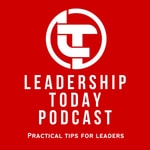Leadership Today - Practical Tips For Leaders – Details, episodes & analysis
Podcast details
Technical and general information from the podcast's RSS feed.

Leadership Today - Practical Tips For Leaders
Andrew Beveridge
Frequency: 1 episode/8d. Total Eps: 297

Recent rankings
Latest chart positions across Apple Podcasts and Spotify rankings.
Apple Podcasts
🇬🇧 Great Britain - management
30/06/2025#72
Spotify
No recent rankings available
Shared links between episodes and podcasts
Links found in episode descriptions and other podcasts that share them.
See all- https://mastersofscale.com/
574 shares
- https://leadership.today/connect
76 shares
RSS feed quality and score
Technical evaluation of the podcast's RSS feed quality and structure.
See allScore global : 48%
Publication history
Monthly episode publishing history over the past years.
Interview - Brad Englert - Spheres of Influence
vendredi 9 mai 2025 • Duration 54:13
Summary
In this conversation, Andrew Beveridge speaks with Brad Englert, founder of Brad Englert Advisory and author of 'Spheres of Influence'. They discuss the importance of mentorship, building genuine relationships in business, and the significance of understanding both internal and external spheres of influence. Brad shares insights from his extensive experience in IT and leadership, emphasising the need for proactive customer service, the power of apology, and the challenges of influencing without formal authority. The discussion also touches on the dynamics of hybrid work environments and the importance of maintaining connections in a remote setting. Learn more about Brad and access a free chapter of his book - https://bradenglert.com/podcast/
Takeaways
- Mentorship is a two-way street, involving both giving and receiving.
- Understanding your boss's expectations is crucial for success.
- Building genuine relationships can lead to long-term success.
- Proactive customer service is more effective than reactive fire drills.
- Apologising can build trust and strengthen relationships.
- Long-term relationships can lead to unexpected opportunities.
- Creating a positive organisational culture requires clear communication and values.
- Navigating crises requires preparation and strong relationships.
- Influencing others without authority is a key leadership skill.
- Hybrid work environments require intentional relationship-building.
Chapters
00:11 Introduction to Brad Englert
03:26 Understanding Spheres of Influence
10:13 Building Genuine Relationships
16:24 Cultural Transformation in IT
23:04 Navigating Crisis and Change
28:58 The Power of Apology
32:24 Communication and Clarity in Leadership
36:52 Understanding Expectations and Influencing Upwards
39:29 Building Customer Relationships
45:02 Influencing Without Authority
48:46 Navigating Hybrid Work Environments
51:59 Looking Ahead: The Future of Leadership
Episode 225 - The Leader’s Mindset - Part Five - Drive for Growth
Episode 225
vendredi 27 septembre 2024 • Duration 04:07
Summary
We each have mindsets that we bring to our leadership. In this final of a five part series, we explore Drive for Growth and the role it plays in The Leader’s Mindset.
Transcript
Hello and welcome to episode 225 of the Leadership Today podcast where each week we share practical tips to improve your leadership. In this final of a five part series, we explore Drive for Growth and the role it plays in The Leader’s Mindset.
We are continuing to explore The Leader’s Mindset which has four elements: Goal Orientation, Optimistic Outlook, Options Thinking and Drive for Growth. I encourage you to listen to the previous episodes first and also take the time to complete our free Mindset to Action assessment. This provides detailed feedback on all four areas along with development suggestions. Just go to https://leadership.today/mta
Continuing our journey metaphor, we can be clear about where we’re going, have a positive attitude towards that journey, and even be great at identifying various options to get there, but without Drive for Growth we won’t make progress.
Drive for Growth is like momentum and making forward progress on the journey. With a Drive for Growth mindset, a person will be motivated to keep going and persist even when things get hard. They push themselves to standards that are greater than the minimum that’s expected. Without a Drive for Growth, a person tends to give up when things become difficult to achieve. They also find it hard to get going on a task they know will be difficult.
Sometimes it can feel like some people are just born with higher levels of drive and motivation, but we can all develop and improve our Drive for Growth. Here are five practical ideas you can use:
- Boost Your Mood: Procrastination is about putting short term mood repair over long term results. We procrastinate because it makes us feel better in the moment. Research demonstrates that boosting your mood by completing an activity you enjoy makes you less likely to procrastinate. Whether it's going for a quick walk or talking with a colleague, take a few moments to boost your mood before you begin.
- Start Small: Getting started can be the hardest part of pursuing any goal. Identify a small first step you can take to make progress. Dedicating a short amount of time such as 10 to 15 minutes to begin can also be a useful approach. You can then add another 10 to 15 minutes on at the end, as you're likely to be more motivated once you get started.
- Review Why It Matters: It's challenging to make progress when we lose sight of why our actions matter. Think about your broader goals and sense of purpose in life. Identify how activities align with this purpose to give you that extra motivation.
- Reflect on Progress: Take stock of the progress you have already made. Think about where you were a month or a year ago and reflect on what you've learned and how you've grown. This will help to build your confidence and motivation to keep going.
- Recognise That Growth is Difficult: Learning anything new is uncomfortable. Feeling awkward and wanting to give up are natural responses to trying any new activity or pushing ourselves out of our comfort zone. It doesn't mean that you lack potential. Push through the awkwardness towards growth and improvement. Becoming comfortable with feeling uncomfortable is a key part of a Drive for Growth mindset.
Choose one of these to practice over the coming week. That’s our final episode in this series on The Leader’s Mindset. If you found the episodes and Mindset to Action assessment helpful, please share them with a friend or colleague. We are committed to sharing resources that help everyone with their leadership and you play a big part in spreading the news. Have a great week as you become an even better leader.
Leadership Today On-Demand Special Offer
We have a great deal for podcast listeners on our Leadership Today On-Demand subscription. Just go to www.leadershiptoday.com and checkout using the promo code PODCAST for 25% off an annual subscription.
Leadership Today On-Demand is a video subscription service that allows you to work on your leadership in your own time and at your own pace. It is available online and through our Apple iOS and Android apps for phones and tablets. Our mission is to help you to become an even better leader.
Your subscription brings together all of our video content in one place including:
- Five online courses with workbooks
- Five five day challenges with workbooks
- Nineteen recorded webinars
- A searchable library of 170+ "how to" quick videos on a range of leadership challenges
That's over $4,500 of content for less than the price of a single online course. And there are more videos added each week.
Get Connected
Find out ways to get connected here: https://leadership.today/connect
Episode 217 - How to Be More Real on Video Calls
Episode 217
vendredi 2 février 2024 • Duration 03:30
Summary
Research demonstrates a risk of detachment and reduced connection on video calls. This week we explore ways to be more real when we’re not meeting in-person.
Transcript
Hello and welcome to episode 217 of the Leadership Today podcast where each week we share practical tips to improve your leadership. This week we look at how to be more real on video calls.
We make rapid judgements about people based on visual and other information we receive. While this can lead to us making incorrect judgements when we meet people in-person, the risk is increased through video calls.
Research demonstrates an increased risk that we treat a visual representation of someone as less real than if we meet them in-person. On a video call we can treat other people as abstract rather than real. This effect is likely increased on a call that has audio and video challenges.
In experiments, participants viewed others as having fewer conscious feelings and less ability to make free choices than when meeting in-person.
As a leader, this could make us seem detached and lacking empathy during the conversation. It can, in turn, lead us to give less ethical consideration to the person on the other end of the video call. Our decision making may lack the warmth, concern and consideration that we would normally provide. So what can we do about this?
When making video calls, we need to be conscious of the risk of detachment and make conscious effort to see people as real human beings. Here are some tips to try:
- Connect as human beings first. Rather than just getting straight down to business, spend a few minutes enquiring about the other person, how they are, and what they have been doing. You might share something personal about yourself to enhance this connection.
- Ask open questions. When we treat people as an object rather than a person, we can tend to “talk at” people rather than “talk with” people. Asking open questions helps avoid this trap.
- Increase your ethical consideration. Explore the impact of any decisions you are making upon people. Great decisions are a combination of logic and emotion.
- Acknowledge the challenge. You might share this research with your team members. This will help everyone to manage the risk of detachment.
- Make the most of in-person opportunities. When you do meet together in-person, use this time to connect on a personal level. Save more administrative activities to video calls and don’t waste the time you have physically together.
Give these tips a try on your next video call, and we can all become more real.
Research summary - https://www.bps.org.uk/research-digest/medusa-effect
Leadership Today On-Demand Special Offer
We have a great deal for podcast listeners on our Leadership Today On-Demand subscription. Just go to www.leadershiptoday.com and checkout using the promo code PODCAST for 25% off an annual subscription.
Leadership Today On-Demand is a video subscription service that allows you to work on your leadership in your own time and at your own pace. It is available online and through our Apple iOS and Android apps for phones and tablets. Our mission is to help you to become an even better leader.
Your subscription brings together all of our video content in one place including:
- Five online courses with workbooks
- Five five day challenges with workbooks
- Nineteen recorded webinars
- A searchable library of 170+ "how to" quick videos on a range of leadership challenges
That's over $4,500 of content for less than the price of a single online course. And there are more videos added each week.
Get Connected
Find out ways to get connected here: https://leadership.today/connect
Episode 136 - Social Status and Collaboration Don’t Mix
Episode 136
vendredi 6 mai 2022 • Duration 03:53
Summary
It turns out that designer labels and other signs of social status can get in the way of collaboration.
Transcript
Welcome to episode 136 of the Leadership Today podcast where each week we bring research to life in your leadership. This week we look at the impact of perceived social status on collaboration.
Research published in the Journal of Personality and Social Psychology found that people who show off signs of social status, like fancy accessories, designer labels and high-end cars, are perceived to care more about self-interest than helping others. As a result, they are seen as less willing to collaborate and more competitive. When I came across this research there were a few examples that stand out in my mind.
The first was a leader who stood at the front of the room, talking to his team about innovation. At the end of his talk he said “speaking of innovation, why don’t you all come out to the car park”. He led the team out to show them his brand new Tesla, taking the next 30 minutes or so to show off every feature of the extraordinarily expensive car. He later received feedback that members of his team found him hard to relate to.
The next was a meeting with a General Manager. In her office I noticed she had a hand bag awkwardly placed on the table where we were meeting - almost like it was on display. I kept wondering why she didn’t take it off the table to give us more space. As we left, my colleague asked me if I noticed the bag. It turned out to be a luxury handbag worth many thousands of dollars. Her peers confided that the General Manager was aloof and not connected with her team.
The third was a meeting I heard about but wasn’t involved in. It was between the CEO of a trucking company and one of his lawyers at a restaurant. The lawyer was in a perfect suit, while the CEO wore functional if slightly dated clothes. At the end of the meeting as they left the restaurant, the CEO saw one of his company’s trucks coming down the road. He waved the driver over and hopped up into the cabin, asking if he and the lawyer could catch a ride back to the head office. Despite owning hundreds of trucks, he knew the driver by name. Apparently this was a regular occurrence. His employees absolutely loved him.
While we don’t want to obsess about our image, it pays to be selective in signs of wealth and social status if your objective is to build collaboration. Be wary of things that might come between you and your people.
Reference
Shalena Srna, Alixandra Barasch, Deborah A. Small. On the value of modesty: How signals of status undermine cooperation.. Journal of Personality and Social Psychology, 2022; DOI: 10.1037/pspa0000303
Episode 135 - Managing Bias
Episode 135
vendredi 29 avril 2022 • Duration 04:07
Summary
We all suffer from bias. Here’s how to manage bias more effectively.
Transcript
Welcome to episode 135 of the Leadership Today podcast where each week we bring research to life in your leadership. This week we look at ways to manage bias.
If you ask people to picture in their mind a doctor, most will automatically assume that the doctor is male. If you ask the same people to picture in their mind a nurse, most will automatically assume that the nurse is female. It’s true - more doctors are male, and more nurses are female. When we guess at someone’s gender based on their profession it’s like we’re using approximations and rules of thumb. We are guessing at what’s most likely. But our guesses can be wrong, and based on faulty assumptions. All of that can lead us to have biases that shape our behaviour. If I’m hiring a doctor, do I tend to dismiss female candidates? If I’m hiring a nurse, do I put males further down the list? My beliefs and assumptions then become a real problem - they can lead to bias and prejudice. Understanding how this occurs can help us to identify and manage our biases more effectively.
A helpful framework for this is the Ladder of Inference from Chris Argyris. Here we picture a ladder that we’re climbing.
- The ladder starts with what we observe. That’s the first rung of the ladder.
- We then select data from what we observe.
- We then add meanings, both cultural and personal, to that data
- We make assumptions based on those meanings
- We draw conclusions based on those assumptions
- Those conclusions shape our beliefs about the world
- We take action based on our beliefs
- All of this loops back to influence what we observe
This process is natural and can be helpful - we need beliefs to guide us through the wealth of data and information coming our way. But it can also be problematic when it ends up with prejudice and unfair treatment. So what can we do?
First, we need to accept that we all have biases. No one is ever bias free, and it is extremely difficult to eliminate a bias completely. But we can reduce bias and we can minimise the impact of bias. To do that, we need to challenge our beliefs. How do we do that? Here are three ideas:
- Pay attention to who you spend time with. Most people tend to spend time with people who are similar to them. Start by going back through your calendar and noting who you’re spending time with.
- Actively seek to work with people who are different to you. Broaden out your inner circle. Look around for the people who are most different to you, whether that’s culture, profession, age, gender or any other factor.
- Become curious about other people. Be genuinely interested in other people and their perspectives. Just listen to understand. You don’t have to agree with everything they say, but you also don’t need to argue back.
Our workplaces will be far more positive if we can effectively manage bias, and it all starts with us.
Episode 134 - Creating Customer Value
Episode 134
vendredi 22 avril 2022 • Duration 03:06
Summary
In this episode we explore how to create customer value in our roles and why it matters.
Transcript
Welcome to episode 134 of the Leadership Today podcast where each week we bring research to life in your leadership. This week we explore how to create customer value in our roles and why it matters.
Creating customer value is central for any successful organisation. If we aren’t creating value for our customers, we are bound to fail. Customer value is also at the core of improvement methodologies such as Lean. At its heart, Lean is a set of improvement methodologies that puts customers and our people at the centre. It is focused on delivering value to customers in the most efficient and effective way possible, using fewer resources and producing less waste. Lean pursues perfection - until we have reached perfection, we can always do better. It also recognises that engaged and motivated people are essential for delivering great outcomes. By relentlessly removing waste and increasing value, we can deliver even better results for our customers. Furthermore, we can achieve this in a way that looks after our people.
Sometimes people struggle to identify their customer or customers. A simple way to do this is to ask - Who uses what we produce? While those people may not be called ‘customers’ within or by your organisation, they are your customers from a value-creation perspective.
In order to create and increase value for our customers, we need to understand what they value. Rather than guessing at their needs, it’s often simplest to have a discussion with them.
We could include open questions like:
- What challenges do you face?
- What matters most to you in the product or service we provide?
- What doesn’t matter?
- What do you like the most about what we provide?
- What do you like the least?
Importantly the conversation needs to focus on them, not just on our product or service. Such open conversations can often highlight new opportunities to add value.
So this week, spend some time getting to know your customers and their needs better, then focus on ways to increase the value you offer them.
Episode 133 - Pride Comes Before a Fall
Episode 133
vendredi 15 avril 2022 • Duration 03:09
Summary
Excessive pride can lead to a range of problems. We can avoid this by practicing humility.
Transcript
Welcome to episode 133 of the Leadership Today podcast where each week we bring research to life in your leadership. This week we explore the importance of practicing humility in order to avoid excessive pride.
We’ve all heard the expression, pride comes before a fall. Being proud of our achievements is fine. The issue is when we elevate ourselves above others or think we are infallible. So whenever there is a track record of success, pride can become a problem.
So what’s the issue with pride? There are three main issues when people become too proud:
- The need to be an expert. Pride can make it hard to say “I don’t know”. This may lead people to make poor decisions based on incomplete information or faulty logic.
- They receive less feedback. If you think you have it all together, people aren’t likely to tell you otherwise. This can reduce the amount of feedback received.
- This combination of a lack of feedback and overestimated ability makes a fall more likely to occur, and even more difficult to take.
So how do we ensure we keep excessive pride in check. The key is to practice humility. Here are five things to try:
- Become aware of your weaknesses, not just your strengths - if you can’t identify any weaknesses, then you are at risk
- Listen to others - genuinely value their input and perspectives
- Be willing to say “I don’t know” - it’s perfectly fine to not have all the answers
- Ask for help when you need it - everybody needs help and support at different points
- Actively seek specific feedback - don’t just ask “how am I doing?” but ask for feedback about specific areas (for example, “I want to improve the way I present - what’s something specific I could improve?”)
Pride doesn’t have to become a problem. If we want to avoid a fall, we can practice humility.
Reference
Episode 132 - Scheduled Decisions Reduce Worry
Episode 132
vendredi 8 avril 2022 • Duration 03:35
Summary
We can so often end up worrying about decisions that we don’t even need to make yet. Here’s how scheduled decisions can help.
Transcript
Welcome to episode 132 of the Leadership Today podcast where each week we bring research to life in your leadership. This week we look at how scheduled decisions can reduce worry.
Have you ever dreamed about leaving a job? Things become challenging so you start to scroll through employment websites, just to see what else is out there. Before you know it your spare time, commute to work, lunch break and other opportunities are punctuated by a quick job search.
Or maybe there’s another type of significant change you need to make at some point. Perhaps this change doesn’t need to happen for a while, but you find your thinking looping back on it repeatedly.
As humans we have an exceptional ability to find things to worry about. There are some things we can’t control or influence where worrying is entirely futile. But there are other things that we do have some control or influence over where worrying can still become a problem.
Here’s a simple technique that I believe can really help. I call it scheduled decision making.
Let’s take the job search example. The problem here is that we haven’t actually decided to leave our current job, so the constant job searching just leads to distraction and dissatisfaction. We haven’t decided to make a decision, so we end up just gathering more and more information as we ruminate on whether we should change jobs.
When coaching people in these sorts of situations, the first question we explore is whether now is the best time to make a decision. Often times now isn’t the best time to decide. There may be a lot going on so the person doesn’t have capacity to work the issue through, or they may not have all the information they need to make the decision, or their decision might just be a reaction to current circumstances. If that’s the case, then we explore a time in the future when they will likely be in a better position to make a decision. Here I ask people to actually choose a date. I then suggest they schedule the decision making process for that date.
In the job search example, let’s say we schedule the decision for two months in the future. That helps us to feel confident we will address the issue - it’s in our calendar. It also makes all that job searching far less important, so we can better focus on today’s challenges. At the two month mark they will make their decision about whether to leave their job or not.
So this week, think about things you are worrying about at work. Is there an opportunity to schedule your decision making for a future date? You might just find it helps you to focus on the present, and leave future problems for a better time in the future.
Episode 131 - Succeeding in a New Role
Episode 131
vendredi 1 avril 2022 • Duration 03:27
Starting a new role can be challenging. In this episode we explore how best to succeed when you’re starting in a new position.
Transcript
Welcome to episode 131 of the Leadership Today podcast where each week we bring research to life in your leadership. This week we explore how best to succeed when you’re starting in a new position.
Starting a new role can be really challenging. There is so much to get your head around. What am I accountable for? How do the systems work? Who’s in my team? We want to set ourselves up well, but what do the most successful people focus on in those first few weeks and months?
Researchers Cross, Pryor and Sylvester found those who are most successful in new roles build broad, mutually beneficial connections right from the start. This helps these so-called “fast movers” to be more engaged, productive and innovative. So how do they do this?
The most effective new starters quickly identify key leaders and influencers across the organisation who are willing and able to help them get things done. Fast movers build these connections quickly, looking for ways they can provide help and support. The key here is that the relationships are mutually beneficial. They don’t just go out asking for help, but look for ways to assist others. Over time this means people come to them to offer advice, support and ideas.
Fast movers think about where they add value through their strengths, while also identifying people who can assist with their gaps. They use their connections to help diagnose their strengths and what they may need to work on in relation to their role.
Fast movers tend to work across the organisation, moving across silos and boundaries. This is incredibly beneficial to organisations that so often struggle to work between different areas and departments. It’s like the glue that holds the organisation together, and that’s part of what makes these fast movers so valuable. Their broader perspective really helps fast movers to stand out from the people who stick to their own area.
So, whether you’re new to a role or not, there are many benefits to be gained by broadening your network across the organisation. Look for ways you can support others while also gaining support. You might start by asking your manager and colleagues for people they rate highly. Schedule some time to meet with these people to find out more about their role and part of the organisation. Look for ways you can assist others across the organisation. It will help you to succeed in your own role.
Reference
https://hbr.org/2021/11/how-to-succeed-quickly-in-a-new-role
Episode 130 - When to Set a Deadline
Episode 130
vendredi 25 mars 2022 • Duration 02:40
Summary
Deadlines can help us, but they can also take us away from what’s most important. This week we explore when to set a deadline.
Transcript
Welcome to episode 130 of the Leadership Today podcast where each week we bring research to life in your leadership. This week we are looking at when to set a deadline.
Deadlines can be really helpful if we use them well. I’ve spoken before about the mere urgency effect - that we tend to focus our attention and efforts towards tasks with a deadline over and above other far more important tasks that don’t have a deadline. Deadlines attract our attention and energy. So if we set deadlines for things that aren’t important, they will draw out attention and energy away from the things that really matter.
But we can use this effect to our advantage. There are plenty of things in life that are important but never really urgent. Things like planning, rest and recovery, exercise, connections with others. We need to schedule these things into our calendar - effectively giving them a deadline.
Here is one example from my own business. Every Monday at 8.30am I review progress against a range of targets for my business. That includes the usuals like sales and delivery, and things like podcast and app downloads. But it also includes exercise, social connections, and time spent away from my family, which I try to keep within a tight range. It’s a routine - a not negotiable. Having a deadline on this helps draw my attention and energy. I can then look at these measures and schedule any actions needed over the coming weeks. It helps me to remain proactive and focused.
So this week, think of the important things in your life that you may have been neglecting. Put them in your calendar with a deadline.









